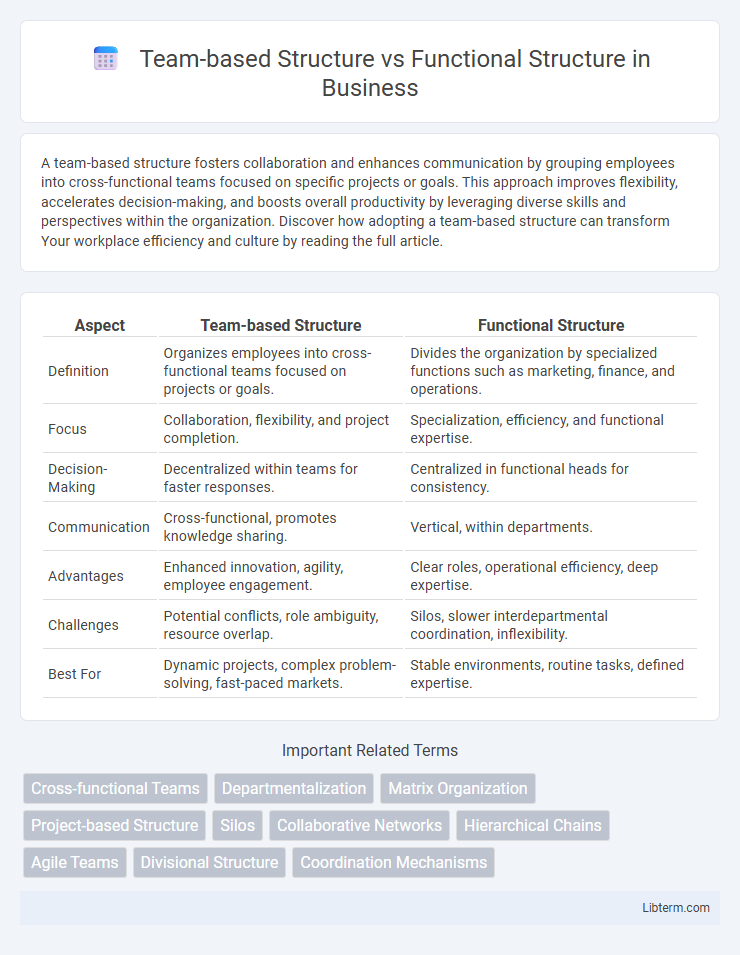A team-based structure fosters collaboration and enhances communication by grouping employees into cross-functional teams focused on specific projects or goals. This approach improves flexibility, accelerates decision-making, and boosts overall productivity by leveraging diverse skills and perspectives within the organization. Discover how adopting a team-based structure can transform Your workplace efficiency and culture by reading the full article.
Table of Comparison
| Aspect | Team-based Structure | Functional Structure |
|---|---|---|
| Definition | Organizes employees into cross-functional teams focused on projects or goals. | Divides the organization by specialized functions such as marketing, finance, and operations. |
| Focus | Collaboration, flexibility, and project completion. | Specialization, efficiency, and functional expertise. |
| Decision-Making | Decentralized within teams for faster responses. | Centralized in functional heads for consistency. |
| Communication | Cross-functional, promotes knowledge sharing. | Vertical, within departments. |
| Advantages | Enhanced innovation, agility, employee engagement. | Clear roles, operational efficiency, deep expertise. |
| Challenges | Potential conflicts, role ambiguity, resource overlap. | Silos, slower interdepartmental coordination, inflexibility. |
| Best For | Dynamic projects, complex problem-solving, fast-paced markets. | Stable environments, routine tasks, defined expertise. |
Introduction to Organizational Structures
Organizational structures define how activities such as task allocation and coordination are directed to achieve company goals. A team-based structure emphasizes collaboration across different functions, enhancing flexibility and innovation by grouping employees into cross-functional teams. In contrast, a functional structure organizes employees based on specialized roles or departments, promoting operational efficiency and clear hierarchy within each function.
Defining Team-Based Structure
Team-based structure organizes employees into cross-functional groups focused on specific projects or goals, enhancing collaboration and flexibility. Each team operates with shared responsibility and decision-making authority, promoting faster problem-solving and innovation. This approach contrasts with traditional functional structures by breaking down departmental silos and fostering a dynamic work environment.
Understanding Functional Structure
Functional structure organizes a company by specialized departments such as marketing, finance, and production, enhancing operational efficiency through expertise concentration. This hierarchy clarifies roles and responsibilities, streamlines decision-making within functions, and supports scalability in large organizations. Understanding functional structure enables better alignment of resources and clear career paths, improving communication and performance within distinct organizational units.
Key Differences Between Team-Based and Functional Structures
Team-based structures emphasize collaboration across various departments, enabling flexible and dynamic project management, while functional structures organize employees by specialized roles within distinct departments, promoting operational efficiency. In team-based structures, decision-making is often decentralized, fostering innovation and quick problem-solving, whereas functional structures rely on hierarchical decision-making with clear chains of command. Resource allocation in team-based environments is fluid to meet project needs, contrasting with functional structures that allocate resources based on departmental budgets and long-term operational goals.
Advantages of Team-Based Structure
Team-based structures enhance collaboration and innovation by fostering diverse skill sets within cross-functional groups, leading to faster problem-solving and increased adaptability. These structures promote employee empowerment and accountability, resulting in higher motivation and improved communication across departments. Organizations benefit from greater flexibility in resource allocation and responsiveness to changing market demands through dynamic team configurations.
Strengths of Functional Structure
The functional structure enhances operational efficiency by grouping employees with similar skills, promoting specialization and expertise within departments such as marketing, finance, or production. This clear division of labor fosters streamlined communication, improved resource allocation, and consistent performance standards. Organizations benefit from increased productivity and cost-effectiveness due to well-defined roles and a hierarchical chain of command.
Common Challenges in Team-Based Structures
Team-based structures often face challenges such as unclear roles and responsibilities, which can lead to confusion and decreased accountability among team members. Communication breakdowns and conflicts may arise due to diverse skill sets and interpersonal dynamics within cross-functional teams. Maintaining coordination and aligning team goals with organizational objectives frequently requires ongoing effort and effective leadership.
Typical Drawbacks of Functional Structures
Functional structures often create silos that hinder communication and collaboration across departments, reducing organizational agility and innovation. Employees may develop narrow skill sets, limiting cross-functional expertise and adaptability to changing market demands. Decision-making can become centralized and slow, as layers of hierarchy create bottlenecks and reduce responsiveness in dynamic business environments.
Choosing the Right Structure for Your Organization
Selecting the ideal organizational structure depends on your company's goals, size, and nature of work. A team-based structure promotes collaboration and agility, making it suitable for dynamic environments requiring innovation and quick decision-making. Conversely, a functional structure offers clear hierarchical authority and specialization, benefiting organizations focused on efficiency and routine operations within defined departments.
Future Trends in Organizational Design
Team-based structures emphasize collaboration across functions, promoting agility and innovation critical for adapting to rapid technological advancements and dynamic market demands. Functional structures, organized by specialized departments, may face challenges in responsiveness but benefit from deep expertise and operational efficiency. Future organizational design trends favor hybrid models that integrate team-based flexibility with functional specialization to balance innovation and efficiency in evolving business environments.
Team-based Structure Infographic

 libterm.com
libterm.com